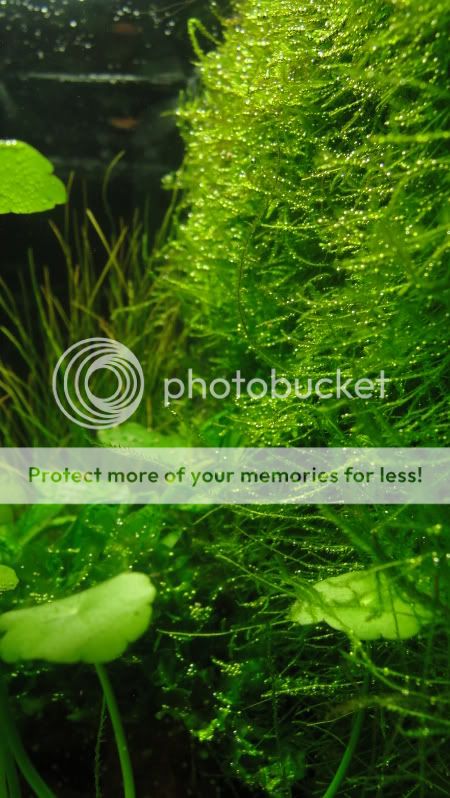This tank is now a year old, so I consider it mature enough to add to this section.
llj's 20g Planted aquarium
Tank 20g, 24"x 12"x 18", All-Glass aquarium, I think. I've had it over 10 years. Used to house a pair of kribs and was then dismantled when the pair died and I got into goldfish in 2000
Filtration Aquaclear 30 (3 sponges), Aquaclear 50 (3 sponges). Both set to maximum flow capacity.
Lighting 3, 14W T5 bulbs, 2.1WPG, one colormax, the other two at 6700k, photo period is 12 hours or more. I use one T5 as sort of a night light until I go to bed.
CO2 Two Nutrafin canisters connected via T-connector to a bubble ladder. DIY mix (1/2cup sugar, 1/2 tsp yeast) changed on alternate days once a week, 1-2 bubbles per second.
Substrate 1-3mm natural gravel, 2-3" depth, supplemented with 24oz of laterite and mixed
Fertilisation Seachem rootabs, dosed every 3-4 months.
Water chemistry pH 6.4, kH 3, other parameters not measured, temperature 68-76 farenheit, depending on the season. This tank is unheated as I live in a very warm climate.
Maintenance 5g water change weekly, gravel vac once a week. Media cleaning once a week. Filter cleaning once a month.
Fish 5 Hyphessobrycon callistus (Serpae tetras), 5 Corydoras aenaeus, 6 Hypessobrycon herbertaxelrodi, 3 Otocinclus affinis, 6 Boehlkea fredcochui, 4 Corydoras peleatus. Soon to add a pair of Scleromystax barbatus.
Plants Bolbitis heudelotii, Anubia barteri var. barteri, Marsilea quadrifolia, Bacopa caroliniana, Rotala rotundifolia, Christmas moss.
Decor Four pieces of Mopani wood interlocked together.
Additional comments This tank was setup in June of 2006. It was originally another high-tech system with 2.8WPG, CO2 injection, and EI and looked like this.

I was getting persistant greenwater, however, and my wood was rotting, so I reduced the lighting to 1.4WPG and replaced the wood about a month or so later. This cleared up the greenwater very quickly and the tank was algae-free until November or December when I got a BBA outbreak on my A. reineckii. I used excel to treat this and nearly killed the A. reineckii as some plants are sensitive to Excel dosing. In retrospect, I should have just removed the infected leaves. The only other major event was an ICH outbreak when I purchased the blue tetras, which was promptly treated with no losses. When I reduced the lighting in this tank, I maintained a jungle scape for quite some time, which I think contributed to the overall stability of this system. Chief among the early stemplants were Egeria densa and Hydrocotyle leucocephala, which are excellent algae-busters. Also, as you can see from the above picture, the Marsilea hirsuta (clover-like plant) is in its emersed form. It took about 4-5 months for the plant to completely transition from emersed to submerged growth. which has several potential leaf shapes, from a single lobe to four lobes.
In late April or early May of 2007, I hooked up another T5 bulb, giving me 2.1WPG. I did this because I was concerned about the decreased efficiency of my T5 bulbs, which were over 2 years old at that point. I also experimented with a more structured scape and removed a lot of rampant moss and Marsilea hirsuta, which was covering some very nice pieces of Mopani driftwood. No sense covering wood you paid a pretty penny for. I also removed the A. reineckii and replaced it with Rotala rotundifolia, which was more subtle and looked better with the wood. Finally, new wood was added to frame the anubias and to contrast with the Marsilea hirsuta, which was forming a lovely foreground along with bare stretches of substrate. The final layout is below.

On the left back corner is R. rotundifolia. On the right back corner, B. caroliniana. Hidden in the wood by the Bacopa is a small rhyzome of Bolbitis, which is hard to make out. In the center, surrounded by wood is a large cluster of Anubia barterii var barterii. There are two small tufts of Christmas moss, and the foreground is bare gravel with two concentrations of Marsilia hirsuta on the left and right of the tank. Some other pictures for your benefit.




Because of the large quantity of Mopani, this tank is consistently the color of weak tea. I personally like this, but others do not. This can be eliminated by either soaking the Mopani for a longer period before adding to the tank or filtering with Activated carbon. In addtion, this tank is overstocked by most standards. I do not recommend this stocking for beginners as you do have to keep up with maintenance, especially in the tanks early stages. On the other hand, I think the plants have benefit from the extra waste produced and the system is now mature enough that it can go nearly a month without water changes and function on zero power for a day or two. Notice, however, that the stocking also consists of minimal-waste producing fish.













 /www.aquaticplantcentral.com/forumap...at-iwagumi.html
/www.aquaticplantcentral.com/forumap...at-iwagumi.html



















